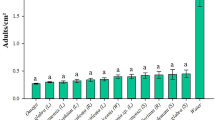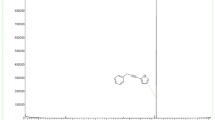Abstract
Eretmocerus mundus is native to the Mediterranean region where it is often observed to enter greenhouses to parasitize B. tabaci on fruiting vegetables and other host crops. Fecundity on tomato and pepper was evaluated by placing newly emerged pairs (n = 15) of E. mundus on leaf discs infested with second instar B. tabaci, the preferred stage, maintained at 25 °C and changed daily until death of the female. All whitefly nymphs were observed for host feeding and inverted to count parasitoid eggs. Adult longevity was estimated at 7.3±0.8 d on tomato and 10.1±1.0 d on sweet pepper. Fecundity (number of hosts parasitized) was estimated 147.8±12.6 per female on tomato and 171.1±21.5 on pepper. Incidence of host feeding (number of hosts killed) was significantly greater on sweet pepper than on tomato, 15.6±1.9 vs. 10.4±1.3 nymphs per female, respectively. No significant differences were detected in the duration of life stages between sweet pepper and tomato. Preimaginal survivorship in clip cages was estimated at 69.5±11.9% on tomato and 76.6±10.5% on sweet pepper, with no statistical differences. Net reproductive rate (R o) was estimated at 63.8±8.2 and 51.0±4.4 on tomato and sweet pepper respectively. Generation time (T) was significantly greater on sweet pepper (19.3±0.5) than on tomato (17.9±0.4), but the estimate of intrinsic rate of increase (r m) was not statistically different at 0.216±0.005 and 0.219±0.004 respectively. These values are well above those reported for B. tabaci on any crop, indicating the potential of E. mundus to control this pest on solanaceous crops in the greenhouse.
Similar content being viewed by others
References
Ardeh, M.J. 2004. Whitefly control potential of Eretmocerus parasitoids with different reproductive modes. Ph.D. dissertation. Wageningen University. The Netherlands
Becker, H., J. Corliss, J. de Quatro, M. Gerrietts, D. Stenft, D. Stanley and M. Wood, 1992. Get the whitefly Swatters-Fast. Agric. Res. Nov. 4–13
Birch L.C. (1948) The intrinsic rate of natural increase of an insect population. J. Anim. Ecol. 17:16–26
Burnett T. (1949) The effect of temperature on an insect host–parasite population. Ecology 30:113–134
Cahill M., Gorman K., Day S., Denholm I., Elbert A., Nauen R. (1996) Baseline determination and detection of resistance to imidacloprid in Bemisia tabaci (Homoptera: Aleyrodidae). Bull. Entomol. Res. 86:343–349
Elbert A., Nauen R. (2000) Resistance of Bemisia tabaci (Homoptera: Aleyrodidae) to insecticides in southern Spain with special reference to neonicotinoids. Pest Manage. Sci. 56:60–64
Enkegaard A (1993) The poinsettia strain of the cotton whitefly, Bemisia tabaci (Homoptera: Aleyrodidae), biological and demographic parameters on poinsettia (Euphorbia pulcherrima) in relation to temperature. Bull. Entomol. Res. 83:535–546
Gameel O.I. (1969) Studies on whitefly parasites Encarsia lutea Masi and Eretmocerus mundus Mercet Hymenoptera Aphelinidae. Rev. Zool. Bot. Afr. 79:65–77
Gelman D.B., Gerling D. (2003) Host plant pubescence: effect on silverleaf whitefly, Bemisia argentifolii fourth instar and pharate adult dimensions and ecdysteroid titer fluctuations. J Insect Sci 3:25
Gerling D, Fried R (2000) Biological studies with Eretmocerus mundus Mercet (Hymenoptera: Aphelinidae) in Israel OILB/SROP Bull. 23:117–123
Gerling D. (1986) Natural enemies of Bemisia tabaci, biological characteristics and potential as biological control agents: a review. Agric. Ecosys. Environ. 17:99–110
Gerling D., Quicke D.L.J., Orion T. (1998) Oviposition mechanism in the whitefly parasitoids Encarsia transvena and Eretmocerus mundus. Biocontrol 43:117–123
Gerling D., Tremblay E., Orion T. (1991) Initial stages of the vital capsule formation in the Eretmocerus–Bemisia tabaci association. Redia 74:411–415
Greenberg S.M., Jones W.A., Liu T.X. (2002) Interactions among two species of Eretmocerus (Hymenoptera: Aphelinidae), two species of whiteflies (Homoptera: Aleyrodidae), and tomato. Environ. Entomol. 31:397–402
Hafaz H, Tawfik MF, Awadallah KT, Sarham AA (1978) Studies on Eretmocerus mundus Mercet (Hymenoptera: Aphelinidae), a parasite of the cotton whitefly, Bemisia tabaci (Genn.) (Homoptera: Aleyrodidae) in Egypt. Bull Soc Ent Egypte 62:15–22
Headrick D.H., Bellows T.S., Perring T.M. (1999) Development and reproduction of a population of Eretmocerus eremicus (Hymenoptera: Aphelinidae) on Bemisia argentifolii (Homoptera: Aleyrodidae). Environ. Entomol. 28:300–306
Horowitz A.R., Gorman K., Ross G., Denholm I. (2003) Inheritance of pyriproxyfen resistance in the whitefly, Bemisia tabaci (Q biotype). Arch. Insect Biochem. Physiol. 54:177–186
Jones W.A., Greenberg S.M. (1998) Suitability of Bemisia argentifolii (Homoptera: Aleyrodidae) instars for the parasitoid Eretmocerus mundus (Hymenoptera: Aphelinidae). Environ. Entomol. 27:1569–1573
Lara L., Urbaneja A. (2002) Control biológico de plagas en pimiento en la provincia de Almería Horticultura 195:86–90
Mackauer M. (1983) Quantitative assessment of Aphidius smithi (Hymenoptera: Aphidiidae): fecundity, intrinsic rate of increase, and functional response. Can. Entomol. 115:399–415
Maia Ade H., Luiz A.J.B., Campanhola C. (2000) Statistical inference on associated fertility life table parameters using jackknife technique: computational aspects. J. Econ. Entomol. 93:511–518
McAuslane H.J., Johnson F.A., Colvin D.L., Sojack B. (1995) Influence of foliar pubescence on incidence and parasitism of Bemisia argentifolii (Homoptera: Aleyrodidae) on soybean and peanut. Environ. Entomol. 24:1135–1143
McAuslane H.J., Nguyen R. (1996) Reproductive biology and behavior of a thelytokous species of Eretmocerus (Hymenoptera; Aphelinidae) parasitizing Bemisia argentifolli (Homoptera: Aleyrodidae). Ann. Entomol. Soc. Am. 89:686–693
Powell D.A., Bellows T.S. Jr. (1992) Adult longevity fertility and population growth rates for Bemisia tabaci Genn (Homoptera: Aleyrodidae) on two host plant species. J. Appl. Entomol. 113:68–78
Qiu Y.T., van Lenteren J.C., Drost Y.C., Doodeman C.J.A.M. (2004) Life history parameters of Encarsia formosa, Eretmocerus eremicus and E. mundus, aphelinid parasitoids of Bemisia argentifolii (Homoptera: Aleyrodidae). Eur. J. Entomol. 101:83–94
Qiu B.L., De Barro P.J., Ren S.X. (2005) Development, survivorship and reproduction of Eretmocerus sp. nr. furuhashii (Hymenoptera: Aphelinidae) parasitizing Bemisia tabaci (Hemiptera: Aleyrodidae) on glabrous and non-glabrous host plants. Bull. Entomol. Res. 95:313–319
Rauch N., Nauen R. (2003) Identification of biochemical markers linked to neonicotinoid cross resistance in Bemisia tabaci (Hemiptera: Aleyrodidae). Arch. Insect Biochem. Physiol. 54:165–176
Rodríguez-Rodríguez Ma.D. 1994. Aleyrodidos. In: R. Moreno Vázquez (ed), Sanidad Vegetal en la horticultura protegida. Consejería de Agricultura y Pesca, Junta de Andalucía, pp. 123–153
Rose M., Zolnerowich G. (1997) Eretmocerus Haldeman (Hymenoptera: Aphelinidae) in the United States, with descriptions of new species attacking Bemisia (Tabaci complex) (Homoptera: Aleyrodidae). Proc. Entomol. Soc. Washington 99:1–27
SAS Institute (1995) The SAS system for Windows, Release 6.11. SAS Institute, Cary, NC
Sharaf N., Batta Y. (1985) Effect of temperature on life history of Eretmocerus mundus Mercet (Hymenoptera, Aphelinidae) Dirasat Agric Sci 23:214–219
Simón, B. 2002. Los biotipos de Bemisia tabaci (Hemiptera: Aleyrodidae) en la Cuenca Mediterránea. Ph.D. dissertation, Universidad de Murcia, Departamento de Genética y Microbiología, Murcia, Spain
SPSS (1999) SPSS Manual del usuario, versión 10.0 para Windows 98. SPSS, Chicago, IL
Stansly P.A., Sánchez P.A., Rodríguez J.M., Cañizares F., Nieto A., López M.J., Fajardo M., Suarez V., Urbaneja A. (2004) Prospects for biological control of Bemisia tabaci (Homoptera, Aleyrodidae) in greenhouse tomatoes of southern Spain. Crop Prot. 23:701–712
Stansly P.A., Calvo J. and Urbaneja A. (2005a) Augmentative biological control of Bemisia tabaci biotype “Q” in Spanish greenhouse pepper production using Eretmocerus spp. Crop Prot. 24:829–835
Stansly P.A., Calvo J., Urbaneja A. (2005b) Release rates for control of Bemisia tabaci (Homoptera: Aleyrodidae) with Eretmocerus mundus (Hymenoptera: Aphelinidae) in greenhouse tomato and pepper. Biol Control 35:124–133
Tawfik M.F.S., Awadallh K.T., Hafez H., Sarhan A.A. (1978) Biology of the aphelinid parasite Eretmocerus mundus Mercet. Bull Soc Entomol Egypte 62:33–48
Téllez M.M., Lara L., Stansly P.A., Urbaneja A. (2003) Eretmocerus mundus (Hym; Aphelinidae), parasitoide autóctono de Bemisia tabaci (Hom: Aleyrodadae): primeros resultados de eficacia en judía Bol San Veg Plagas 29:511–521
Urbaneja A., Stansly P.A. (2004) Host suitability of different instars of the whitefly Bemisia tabaci biotype “Q” for Eretmocerus mundus. Biocontrol 49:153–161
Urbaneja A., Cañizares P., Lopez M.J., Sánchez P.A., Nieto A., Rodriguez J.M., Fajardo M., Suarez T., Stansly P. (2002a) Control biológico de plagas en tomate tolerante al TYLCV. Phytoma 141:60–68
Urbaneja A, Stansly P, Calvo J, Beltrán D, Lara L, van der Blom J (2002b) Eretmocerus mundus: control biológico de Bemisia tabaci. Phy. Esp. 144:139–142
Van der Blom J. (2002) La introducción artificial de la fauna auxiliar en cultivos agrícolas. Bol. San. Veg. Plagas 28: 109–120
Acknowledgments
H. McAuslane (University of Florida) and D. Gerling (University of Tel Aviv) and two anonymous reviewers provided useful comments on early drafts of the manuscript. The authors thank Aureliano Cerezuela (Seminis Vegetables Seeds Ibérica, S.L.) for seeds and Ana Gallego, Javier Calvo, Juani López and David Beltrán (Koppert B.S.) for technical assistance. The Ministry of Science Technology of Spain provided partial funding through Grant number CDTI 00-0152. E.S. was the recipient of a grant from Koppert.
Author information
Authors and Affiliations
Corresponding author
Rights and permissions
About this article
Cite this article
Urbaneja, A., Sánchez, E. & Stansly, P.A. Life history of Eretmocerus mundus, a parasitoid of Bemisia tabaci, on tomato and sweet pepper. Biocontrol 52, 25–39 (2007). https://doi.org/10.1007/s10526-006-9014-8
Received:
Accepted:
Published:
Issue Date:
DOI: https://doi.org/10.1007/s10526-006-9014-8




